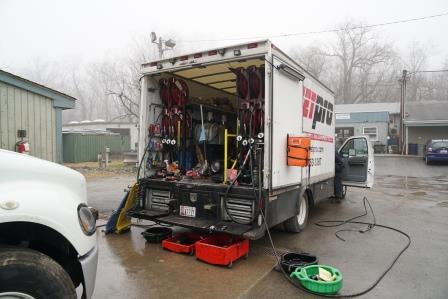Fleetpro provides On-Site Preventive Maintenance and Inspection services to commercial, municipal, and federal vehicle and equipment fleet customers. Currently, over 300 clients service over 14,000 units in the Mid-Atlantic region with Fleetpro. By providing hundreds of thousands of high quality services since 1982, Fleetpro has identified and implemented the elements necessary to maintaining dependable, high- quality service in the On-Site Maintenance business. These include:
- A set of products to properly meet the maintenance needs of commercial-grade fleets that, upon delivery, will result in lower fleet costs and higher productivity.
- Service procedures, standards, and policies combined with a quality-based incentive pay plan to provide the products and services at the highest quality level.
- Cost-efficient systems to reliably deliver the products, including equipment, fluid delivery and oil evacuation systems in both truck-mounted and fixed distribution (depot) versions.
- Recruitment and training programs that ensure a quality versed technical staff.
- An Operations Management system supported by an operations manual that documents the daily, weekly, and monthly requirements.
- A computer-based system to provide support for training, operations, vehicle and usage information, exception reporting, PMI scheduling, logistics management, vehicle key management, services reporting, and required follow-up notifications.
A typical Fleetpro customer profile includes vehicle or equipment fleets of 10 to 4000 units. Logistically, these fleets are located in parking lots, at job sites, or even in front of repair shops – during the workday, at night, or weekends. Fleetpro services support in-house or contractor repair and maintenance programs. Inspection results are documented in the proprietary exception reporting system. It is common for Fleetpro customers to report a 25% reduction in repair and maintenance costs. This does not include the “soft” dollar savings and productivity increases, which are high.
System Features and Benefits | PMI Service Schedule | Fleet Order | Workorder | Out-of-Service Notice | Exception Report | Vehicle Service History | Invoices/Statements
System Features and Benefits
Fleetpro customers report direct fleet cost reductions from 10% to 38% with indirect cost reductions of the same or even greater magnitude. Further, they report increased productivity in user department and core business activities.
OFF-HOURS SERVICE
- Increases fleet availability rate
- Increases fleet, driver and mechanic productivity
- Minimizes impact of fleet down sizing
- Reduces spare vehicle requirements
QUALITY SERVICE MEETING CUSTOMER EXPECTATIONS
- Reduces repair costs
- Reduces downtime
- Meets Federal and State regulatory requirements
- Greatly reduces catastrophic failures and resultant operations impact
EXCEPTION REPORTING SYSTEM
- Allows better turn around time of repair work
- Increases the percentage of scheduled repair work
- Reduces the operating budget; i.e., repair costs
- Enables shop to prepare or order parts requirements
- Helps management make vehicle disposition decisions
MANAGEMENT INFORMATION SYSTEM
- Reports and prioritizes repair work for mechanics
- Helps identify trends in maintenance problems
- Tracks and monitors vehicle and equipment use
- Allows management to identify under-utilized units for capital reductions
- Meets manufacturers’ recommended service requirements
PM SCHEDULING AND DISPATCH
- Increases the efficiency and reliability of the scheduling and delivery process
QUALITY CONTROL SYSTEM
- Provides consistent high quality PMI services
- Identifies trends in the level of service quality
INDEPENDENT INSPECTIONS
- Provides natural checks and balances of PM’s and repairs
- Promotes very accurate reporting of needed repairs and acts as a management tool to evaluate repairs completed
INVENTORY MANAGEMENT
- Reduces bulk fluid inventory
- Reduces waste oil management and disposal requirements
- Reduces inventory shortage problems
ON-SITE SERVICE
- Reduces shuttle costs to garages for routine service
- Increases fleet user satisfaction by not interrupting daily operations for PMI
- Extends capacity of garage facilities and maintenance personnel
REPORTING PACKAGE DESCRIPTION
Fleetpro’s state of the art computerized reporting system keeps customers well informed of each vehicle’s services and scheduling requirements. The reporting package includes the following reports:
To view sample reports, click “View Report”
is furnished monthly to project updated vehicle usage. Our PMI Service Schedule identifies vehicles due for service based on manufacturers’ recommendations and customer’s specific fleet requirements. View Report
verifies the units scheduled for service with the customer, the type of service schedule by unit, the window of service time available to Fleetpro, the location of vehicles scheduled for service, and any appropriate trip or wait charge. View Report
is the foundation of our reporting system, and provides the Record of Inspection for each vehicle serviced. The Fleetpro crew foreman completes this 2-part form during each service. One copy is left for the customer, and Fleetpro maintains the second copy. Information from the workorders is entered into our computer database and printed out on the “Exception Report.” View Report
Fleetpro’s procedures identify and report unsafe or restricted conditions on the customer’s vehicles. View Report
summarizes all service and inspection problems noted on each vehicle’s workorder. Also contained in this report are detailed exceptions on each vehicle’s fluid usage and brake condition when brakes are inspected. Use of this report will allow customers to schedule, in advance, those items in need of repair or further inspection by qualified mechanics. View Report
provides a complete record of the type of service performed, dates, mileage or hours, and intervals for each vehicle. View Report

